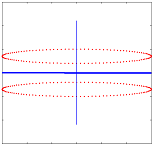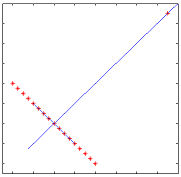

PCA
LPP
PCA
LPP
The blue line segments describe the two bases. The first basis is shown as a longer line segment, and the second basis is shown as a shorter line segment. As can be seen, LPP has more discriminating power than PCA.
The blue line segments describe the two bases. The first basis is shown as a longer line segment, and the second basis is shown as a shorter line segment. Clearly, LPP is insensitive to the outlier at the right top corner.